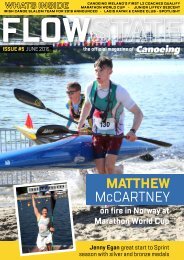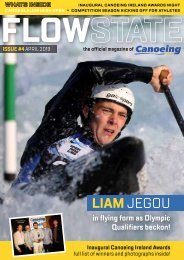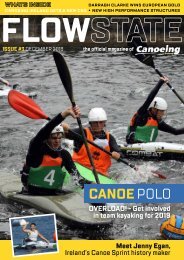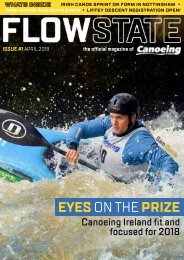You also want an ePaper? Increase the reach of your titles
YUMPU automatically turns print PDFs into web optimized ePapers that Google loves.
PATRICK
O’LEARY
the balance was very careful between both. I was still on the cusp of
qualifying for the K1 as before, but I felt I was improving in the Va’a and that
proved to be the case finishing 5th for a clear qualification and with a year
to go to the Games (or 2 as it happens). There was considerable relief to
get it done a year out and, I was the first person to qualify a slot for Team
Ireland in the Paralympic Games in Tokyo which is a great place to be. I
don’t think any race to qualify for a Games can be easier. It is a huge
amount of pressure but I always race myself and never the opposition. My
lane is in my control and only my lane, so I go as fast as I can in the lane and
if that’s good enough -so be it.
For the Rio 2016 Paralympics you qualified in the KL3 category, and for
these upcoming Games you qualified through the VL3, finishing 5th in
the World Championships. Why the change in category? And how did
you find the switch? Was there much of a change in the training?
Patrick O’Leary made history at the
2016 Paralympic Games becoming
Irelands first ever Paralympian in
paddlesports. There, racing in the
KL3 category, Patrick made the final at the Rio
Paralymipcs. Since this fantastic performance
Patrick has started into a new category in
Paracanoe, the Va’a, and has gone on to qualify
for the upcoming Tokyo Paralympics in the
VL3 category. We spoke to Patrick about his
training during lockdown, qualifying for his
second Games, and how the lead in to an
uncertain 2021 is looking.
To get right to the main question on everyone’s minds, what
are your thoughts on the postponement of the Tokyo
Paralympic Games? And what are your views on the running
of the event in 2021?
Obviously I was really disappointed with the postponement but, it
was the right decision. Part of the Paralympic experience is the
ability to mix with your fellow athletes and be part of a global
community. Given the uncertainty in the summer, if the Games
were held, it would have been a very isolated experience with
everyone in very strict pods and no family travelling. I think the
2020 +1 event will still be Covid affected but the world has much
more knowledge on what is required to keep us all safe. Of course,
I would love a vaccine to positively impact on the games running
and, there is hope of that but even without it I hope the games will
be a success. Just last week I finally bought the event tickets for
my family. I really hope the vaccine comes through and that they
can travel as they were such an important part of the journey and
were a huge support to me in Rio. It was a very strange season
with no races at all this year, just time trials and training so I hope
to be able to have some racing next season, starting in
March hopefully.
This will be your second outing flying the Irish flag at a
Paralympic Games. How was it qualifying for another Games?
Was it easier as you had experience of the level required? And,
was it just as exciting as qualifying for the first?
This was a very different experience. Paracanoe has two
qualification opportunities; one in the year prior to the games
(2019) and one in the year of the games which were held in Szeged
2020 this time round. Before the Rio Games (2016), I just missed
out on qualification the year before and had to qualify in Duisburg
(Germany) the May before the games. In that case because of
continental quotas I really had to win the B final to be sure of
qualifying and, I did! It was the real embodiment of all or nothing
and I was really proud to deliver that day. Qualifying in May was hard
and myself and Neil Fleming, my coach, learned some useful things
about the difficulty of coming down to earth after that high and
rebuilding for Rio in August/September.
This time round because I was trying to qualify in two events
So, I still race the K1 as well as the Va’a and the advantage is, as I have
qualified in one, I can race in both events. I have raced both at world
championships in both events previously. In Rio, the only events that were
in the Paralympic programme were the K1 events in which I am classified as
KL3. There are 3 classes KL1, KL2 and KL3. As a KL3 I am in the most able
class. Paracanoe as a newish sport has fewer classes than running or
swimming because paracanoe had a limit on the number of events in the
Games. Regarding my disability, I am an above-knee amputee on my left
side. This would be one of the more severe disabilities in my class. Many of
my competitors would have both legs, albeit with issues like fused ankles. I
am really competitive, but it does make it really hard racing. After Rio it was
announced that the Va’a events would be added to the Tokyo programme.
Va’a is an outrigger canoe paddled from a sitting position similar to an OC1.
It is propelled with a single blade and critically has no rudder, so all steering
is via either switching paddle side during the race (Polynesian or southern
hemisphere style -typically) or via a ‘J’ stroke (European style). It is an
event in which power is a critical factor. Looking at the power aspect which
is my strength and also looking at the slightly different classification rules
for Va’a it seemed there may be an opportunity for me. The VL3
classification requires at least an above-knee amputation or similar so I
would be on a more even playing field that way.
The big issue for me was that I had never paddled a canoe, I was a
kayaker. I borrowed and then bought an OC1 and removed the rudder and
then in the first year raced using the switching style and went from more
than 1 minute for 200m in my first race to a decent place in the B final of
the worlds in ~53 seconds. I knew I was capable of huge improvement and
bought a sprint Va’a for my second season training and racing. I decided I
was never switching again, now I only stroke on my strong side now. I got
my PB (personal best) down to 49 seconds and finished 5th in the World
Championships to qualify for Tokyo. Last year, I trained in both boats and I
have this year as well. I feel really comfortable in the Va’a now so I’m really
hopeful of pushing that PB down again. To medal in Tokyo I reckon I need
to be capable of a low 48 seconds race.
It’s a beast of a boat! Canoes can help their direction with a lean to
counteract the natural turning effect of always stroking on one side but
with the outrigger you can’t lean, so your stroke has to be very precise.
Also, the Va’a boats are longer than a K1 which means if they start to turn it
can be very hard to correct and correction costs speed. The only solution
to this is lots of Km’s in the boat. The advantage is that it adds variety as I
train on my own the majority of the time. Variety is nice.
Speaking of training. As with most Irish athletes you had to deal with
a new training environment during the lockdown earlier in the year
and now, again, during these Level 5 restrictions. How did your
training change during this time? And, what was your training set up
and routine?
I’m really lucky to have an erg’ (ergometer) in my shed so I could do my
paddle sets in there which, while boring, did get me through the complete
lockdown. I was working from home completely at that stage also. I am
currently Head of the School of Chemistry in NUI Galway and we were
10 11










